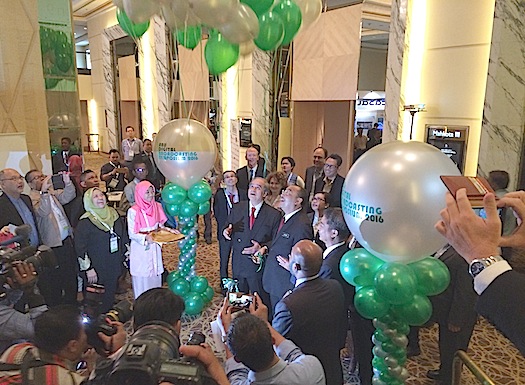The connected environment “is providing great opportunities and also challenges” for broadcasters, said Javad Mottaghi, opening the 2016 Digital Broadcasting Symposium in Kuala Lumpur today.
“The industry is crying out for innovative content ideas to take advantage of the new connected technology,” he said.
This year a record number of registrations for the Symposium have been received from 56 countries and 200 organisations.
Malaysian Deputy Communications Minister Jailani Johari (pictured) opened the conference by launching balloons at the exhibition after an introductory speech where he urged broadcasters to use technology to respond to the changing demands of audiences (see related report).
In the first conference session, Commercial Radio Australia’s Joan Warner said radio must take advantage of new technology to continue to be everywhere. “It is imperative that radio remains relevant in today’s busy media landscape… listeners have less time and more choice of content.”
The two current priorities for the Australian radio industry are to ensure radio receivers are in phones and that radio continues to have a prime place in cars.
She promised some big news within weeks about developments in the mobile phone area, and also described progress for digital radio receivers in cars.
“Getting broadcast radio into mobile phones allows people to save on data costs when they listen to free-to-air radio… An international consortium is working on this and we expect some exciting announcements soon,” she said.
Warner says new connected dashboard technology is growing, but will not replace radio in cars. “All our listener research shows that people still want free to air broadcast radio in their cars… streaming is unable to replicate the robust live local free to air features of broadcast radio.”
She reminded delegates that radio makes its personalities into celebrities who maintain a unique connection with listeners.
“Listeners love their radio presenters and are loyal to them. Radio maintains a connection with listeners… A recommendation from an on air radio personality is word of mouth advertising at its best, there is a high level of loyalty and trust. Radio has used technology to bring the audience closer to our radio talent.”
Conversations continue throughout the day on station websites, twitter, facebook and instagram “because the audience wants to keep talking with their favourite radio presenters,” said Warner.
Radio generates impressive social media engagement. Radio had three times more engagement with listeners than other industry categories in Australia.
“Radio is driving innovation in social media to extend the reach of our stars to engage with listeners.” Warner used examples from ARN’s twitter green room and SCA’s YouTube Hits channel as examples of the continuing social media innovation of radio companies.
The new generation of radio listeners demands more interactivity, and another way that radio is providing that interactivity is through hybrid radio, which combines IP interactivity with free to air broadcasts.
The EBU’s Head of Radio Graham Dixon said broadcasters are striving to be portrayed as modern. Digitla Radio will help with this, he said: “Audio broadcasting is trying to push forward and experiment so that it gives radio a contemporary feel. The reason for making sure radio is perceived as a modern medium is to serve listeners better and fulfil radio’s remit.
BBC technologist Lindsay Cornell gave an update of developments in DAB digital radio standards.
The development of new character sets so that all Latin-based languages can now be seen properly on digital radio screens has been an important goal, which has now been achieved. World DAB is now working on the development of an ASEAN character set to produce digital radios that will render Asian characters, such as Chinese.
“The problem is not in transmitting alphabetical characters,” said Cornell, “it is in decoding them on the digital radio screen. These innovations are allowing more languages to be displayed on screens.”
Hybrid Radio is a combination of broadcast and IP radio. Cornell told delegates that the technical specifications for delivering Hybrid Radio are now in progress. There is a new specification for developing receiver ‘rules of behaviour’ so that car digital radios will refresh stations lists with new stations that come into range, but will not delete stations that you want to listen to when you drive back into your original listening area.
The World DAB Technical Committee is revising all standards to make sure that the costs of production are as low as possible, while delivering the best rich services that digital radio can provide.
Malaysian Deputy Communications Minister Jailani Johari opened the symposium by talking about how audiences across the Asia Pacific region want better services from broadcasters.
“More users are demanding better services from new broadcasting technologies. New Technology is bringing new competition for broadcasters, but it also provides broadcasters with new business opportunities to enhance delivery to their audiences.
“Consumer needs will shape the future of the broadcast industry… They are demanding more content to be available on any device when they need it,” he said.
He commended RTM for starting its own online on demand platform called MyClick, to address consumer demand
“Malaysia is keen on digital transformation of the broadcasting industry. We have a digital migration plan which is being implemented as a national agenda item… our region is leading this wave of change,” said Johari.
“More users are demanding better services from new broadcasting technologies. New Technology is bringing new competition for broadcasters, but it also provides broadcasters with new business opportunities to enhance delivery to their audiences. Consumer needs will shape the future of the broadcast industry… Consumers are demanding more content to be available on any device when they need it.”

